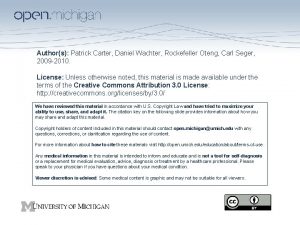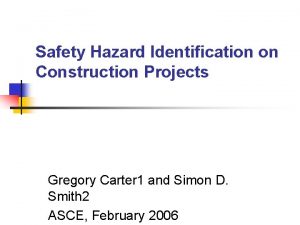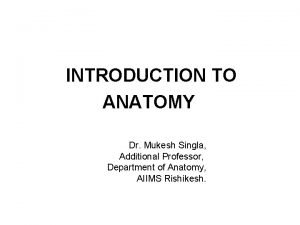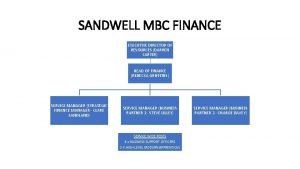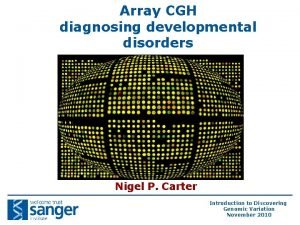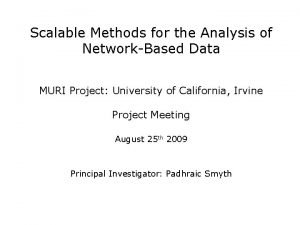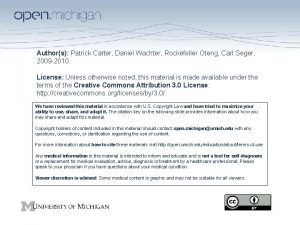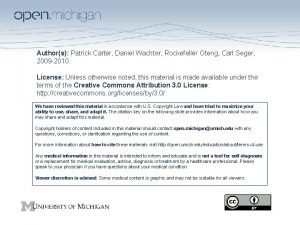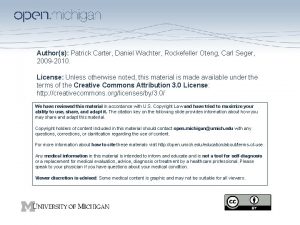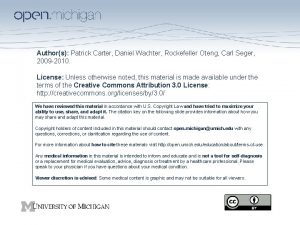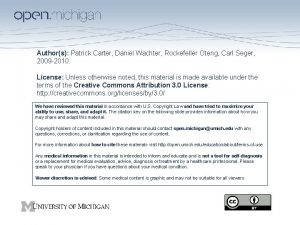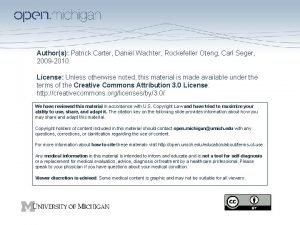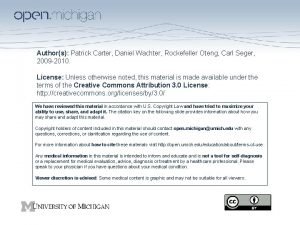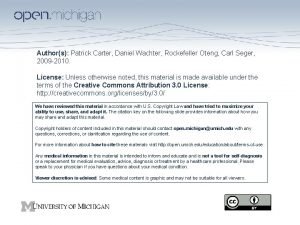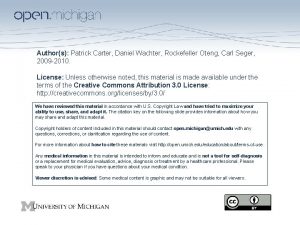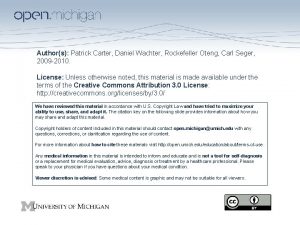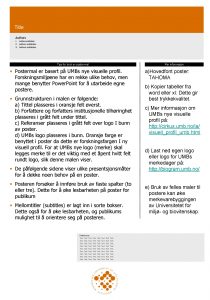Authors Patrick Carter Daniel Wachter Rockefeller Oteng Carl


























































- Slides: 58

Author(s): Patrick Carter, Daniel Wachter, Rockefeller Oteng, Carl Seger, 2009 -2010. License: Unless otherwise noted, this material is made available under the terms of the Creative Commons Attribution 3. 0 License: http: //creativecommons. org/licenses/by/3. 0/ We have reviewed this material in accordance with U. S. Copyright Law and have tried to maximize your ability to use, share, and adapt it. The citation key on the following slide provides information about how you may share and adapt this material. Copyright holders of content included in this material should contact open. michigan@umich. edu with any questions, corrections, or clarification regarding the use of content. For more information about how to cite these materials visit http: //open. umich. edu/education/about/terms-of-use. Any medical information in this material is intended to inform and educate and is not a tool for self-diagnosis or a replacement for medical evaluation, advice, diagnosis or treatment by a healthcare professional. Please speak to your physician if you have questions about your medical condition. Viewer discretion is advised: Some medical content is graphic and may not be suitable for all viewers.

Citation Key for more information see: http: //open. umich. edu/wiki/Citation. Policy Use + Share + Adapt { Content the copyright holder, author, or law permits you to use, share and adapt. } Public Domain – Government: Works that are produced by the U. S. Government. (USC 17 § 105) Public Domain – Expired: Works that are no longer protected due to an expired copyright term. Public Domain – Self Dedicated: Works that a copyright holder has dedicated to the public domain. Creative Commons – Zero Waiver Creative Commons – Attribution License Creative Commons – Attribution Share Alike License Creative Commons – Attribution Noncommercial Share Alike License GNU – Free Documentation License Make Your Own Assessment { Content Open. Michigan believes can be used, shared, and adapted because it is ineligible for copyright. } Public Domain – Ineligible: Works that are ineligible for copyright protection in the U. S. (USC 17 § 102(b)) *laws in your jurisdiction may differ { Content Open. Michigan has used under a Fair Use determination. } Fair Use: Use of works that is determined to be Fair consistent with the U. S. Copyright Act. (USC 17 § 107) *laws in your jurisdiction may differ Our determination DOES NOT mean that all uses of this 3 rd-party content are Fair Uses and we DO NOT guarantee that your use of the content is Fair. To use this content you should do your own independent analysis to determine whether or not your use will be Fair.

Advanced Emergency Trauma Course Gastrointestinal and Genitourinary Trauma Presenter: Daniel Wachter, MD Ghana Emergency Medicine Collaborative Patrick Carter, MD ∙ Daniel Wachter, MD ∙ Rockefeller Oteng, MD ∙ Carl Seger, MD

Lecture Objectives n n Review relevant GI and GU anatomy Understand patterns and pathophysiology of traumatic GI and GU injury Explain the diagnostic modalities appropriate for particular traumatic GI/GU conditions Describe an algorithmic approach to GI and GU traumatic injury evaluation and management Ghana Emergency Medicine Collaborative Advanced Emergency Trauma Course

Potential Injury by Anatomic Region: (Most commonly injured organs in red) n Intrathoracic Abdomen • Diaphragm, liver, spleen, stomach. • Cannot be palpated as it lies behind the ribs. n Pelvic Abdomen: • Urinary bladder, urethra, rectum, small intestine, • Ovaries, fallopian tubes, and uterus in women • Consider extra-peritoneal injuries in this region. n Retroperitoneal abdomen • Contains the kidneys, ureters, pancreas, aorta, and vena cava • Usually require advanced imaging to identify and diagnose these injuries. n Abdomen (proper) • Contains the small and large intestines, gravid uterus, and the distended urinary bladder. • Physical exam, x-rays and DPL are useful and reliable in this area. Ghana Emergency Medicine Collaborative Advanced Emergency Trauma Course

Gastrointestinal Anatomy Lady. Of. Hats (Wikipedia) Ghana Emergency Medicine Collaborative Advanced Emergency Trauma Course

Pathophysiology n Blunt Traumatic Injury: Three injuries patterns • Rapid Deceleration – shearing injury n Injures hollow, solid, visceral organs or vascular structures • Crush n Abdominal anteriorly and vertebrae or ribs posteriorly. • External Compression n Can occur throughout the abdomen May cause diaphragmatic or hollow viscous rupture Penetrating Injury –stabs and projectiles Ghana Emergency Medicine Collaborative Advanced Emergency Trauma Course

Pathophysiology n Solid visceral Injuries • Liver, Spleen, Pancreas, Kidney n Gastrointestinal/Hollow viscus injuries • Duodenal injuries • Small Bowel n n Retroperitoneal Injuries Diaphragmatic Injuries Ghana Emergency Medicine Collaborative Advanced Emergency Trauma Course

Diagnostic Evaluation of Penetrating Trauma: Stab Wounds n n Unstable patients or those with peritonitis should be considered emergently for laparotomy. Stable patients can undergo local wound exploration. If no peritoneal violation is detected, serial examinations are performed. Ghana Emergency Medicine Collaborative Advanced Emergency Trauma Course

Stab Wound Diagnosis n Diagnostic Peritoneal Lavage (DPL) or Focused Abdominal Sonography for Trauma (FAST) • FAST scan is preferred due to higher positive predictive value, but both are acceptable. n n • Further discussion of DPL and FAST follows Perform AP/Lateral Chest x-ray for diaphragmatic, mediastinal or lung injury. CT scan be considered, but is not always mandatory in anterior abdominal stab wounds Ghana Emergency Medicine Collaborative Advanced Emergency Trauma Course

Stab wound www. trauma. org Ghana Emergency Medicine Collaborative Advanced Emergency Trauma Course

Diagnostic Evaluation of Penetrating Trauma: Projectile Wounds n n n Unstable patients suffering projectile wounds to the abdomen should proceed emergently to the operating theater. The specific location of projectile fragments can be investigated after stabilization is achieved. Stable patients suffering projectile wounds to the abdomen should undergo CT scanning and serial examinations. Ghana Emergency Medicine Collaborative Advanced Emergency Trauma Course

GSW to RUQ www. trauma. org Ghana Emergency Medicine Collaborative Advanced Emergency Trauma Course

Blunt Traumatic Injury www. Trauma. org Ghana Emergency Medicine Collaborative Advanced Emergency Trauma Course

Evaluation after Blunt Abdominal/Pelvic Injury Physical Examination n Diagnostic Imaging n • Plain radiography • Ultrasound • CT scan n Diagnostic Procedures Ghana Emergency Medicine Collaborative Advanced Emergency Trauma Course

Physical Exam: Abdomen Observe for distension n Listen for bowel sounds n Palpate for tenderness n “Gray Turner” sign is ecchymosis of flank from retroperitoneal injury n Ghana Emergency Medicine Collaborative Advanced Emergency Trauma Course

Grey-Turner Sign http: //en. wikipedia. org/wiki/File: Hemorrhagic_pancreatitis_-_Grey_Turner%27 s_sign. jpg Ghana Emergency Medicine Collaborative Advanced Emergency Trauma Course

Physical examination: Pelvis n n Compress the Anterior Superior Iliac Crests to assess for pain or movement on PA compression. Compress the Anterior Superior Iliac Crests laterally for pain or movement. Palpate at the pubic symphisis for tenderness, step-off or crepitance. Pelvic fracture are painful and usually demonstrate tenderness. Ghana Emergency Medicine Collaborative Advanced Emergency Trauma Course

Check the Back/Rectal n n Log-roll the patient while observing spinal precautions. Look and palpate for step-offs, abrasions • Bullet holes or stab wounds n Perform rectal exam for gross blood bony pelvic fragments or “high-riding” prostate. Ghana Emergency Medicine Collaborative Advanced Emergency Trauma Course

CXR – Diaphragmatic Rupture www. Trauma. org Ghana Emergency Medicine Collaborative Advanced Emergency Trauma Course

CXR – Viscus Rupture n Free Air below the diaphragm http: //ejournal. afpm. org. my/Assets/factory_worker_chest_radiograph 2. jpg Ghana Emergency Medicine Collaborative Advanced Emergency Trauma Course

FAST Exam n n Focused Abdominal Sonography in Trauma 4 views of the abdomen to look for fluid. • • RUQ/Morrison’s pouch Subxiphoid – view of heart LUQ – view of splenorenal junction Bladder – view of pelvis Ghana Emergency Medicine Collaborative Advanced Emergency Trauma Course

FAST Has largely replaced deep peritoneal lavage (DPL) n Bedside ultrasound looking for blood collection in an unstable patient. n If the patient is unstable and a blood collection is found, proceed emergently to the operating theater. n Ghana Emergency Medicine Collaborative Advanced Emergency Trauma Course

FAST n n n Sensitivity of 94. 6% Specificity of 95. 1% Overall accuracy of 94. 9% in identifying the presence of intraabdominal injuries. • Yoshil: J Trauma 1998; 45 Ghana Emergency Medicine Collaborative Advanced Emergency Trauma Course

FAST Right Upper Quadrant -Morrison’s Pouch n n Between the liver and kidney in RUQ. First place that fluid collects in supine patient. Ghana Emergency Medicine Collaborative Advanced Emergency Trauma Course

FAST Exam - RUQ Source: University of Louisville ED website www. louisville. edu/medschool/emergmed/ult rasoundfast. htm Ghana Emergency Medicine Collaborative Advanced Emergency Trauma Course

FAST - Subxiphoid n n Evaluate for pericardial fluid View through liver • Transhepatic or Parasternal n Searches for fluid between heart and pericardium Ghana Emergency Medicine Collaborative Advanced Emergency Trauma Course

FAST - Subxiphoid Source: University of Louisville ED website www. louisville. edu/medschool/emergmed/ultrasoundfa st. htm Ghana Emergency Medicine Collaborative Advanced Emergency Trauma Course

FAST – Left Upper Quadrant n n n View between the spleen and kidney Another dependent place that fluid collects Also see diaphragm in this view Ghana Emergency Medicine Collaborative Advanced Emergency Trauma Course

FAST - LUQ Source: University of Louisville ED website www. louisville. edu/medschool/emergmed/ultraso undfast. htm Ghana Emergency Medicine Collaborative Advanced Emergency Trauma Course

FAST – Bladder View n Evaluates for fluid in the pouch of Douglas • Posterior to bladder. n Dependent potential space. Ghana Emergency Medicine Collaborative Advanced Emergency Trauma Course

FAST – Bladder View Source: University of Louisville ED website www. louisville. edu/medschool/emergmed/ultrasoundfast. h tm Source: University of Louisville ED website www. louisville. edu/medschool/emergmed/ultrasoundfas tm Ghana Emergency Medicine Collaborative Advanced Emergency Trauma Course

Interpret this FAST Image: Source: University of Louisville ED website www. louisville. edu/medschool/emergmed/ultrasoundfast. htm Ghana Emergency Medicine Collaborative Advanced Emergency Trauma Course

Diagnostic Procedures n Diagnostic peritoneal lavage • Bedside test for expeditious discovery of free peritoneal blood. • Used in multiply injured, altered mentation or to more closely investigate those whose exam is confounded by pelvic or thoracic injuries. • Semi-open technique is preferable to percutaneous technique • Performed at infraumbilical site unless the patient is pregnant or a large pelvic hematoma is suspected. Ghana Emergency Medicine Collaborative Advanced Emergency Trauma Course

Diagnostic Peritoneal Lavage n n DPL must not delay transport to the operating theater when emergent laparotomy is needed regardless of DPL findings. Complications of DPL include: • • Bleeding, Infection Intra-abdominal injuries False-positive leading to unnecessary exploratory laparotomy. Ghana Emergency Medicine Collaborative Advanced Emergency Trauma Course

DPL: Findings Mandating Surgery n n Greater than 10 m. L gross blood on catheter insertion, or greater than 15 -20 m. L on aspiration Following peritoneal lavage with one liter (1 L) crystalloid: • Greater than 100, 000 RBC/mm 3, or • Greater than 500 WBC/mm 3, or • Bile, food matter, high amylase, bacteria Ghana Emergency Medicine Collaborative Advanced Emergency Trauma Course

Pelvic Fractures n n Can be stable or unstable. If unstable, they must be repaired by orthopedics. May have significant bleeding from vessels on pelvic floor. Pelvic fractures should be stabilized with a sheet wrapped tightly around the pelvis. Ghana Emergency Medicine Collaborative Advanced Emergency Trauma Course

Pelvic Fracture n n Pelvic Ring Fractures have a high association with abdominal/pelvic injuries Pelvic Fracture – “Open Book” http: //emedicine. medscape. com/article/394515 -overview Ghana Emergency Medicine Collaborative Advanced Emergency Trauma Course

Pelvic Fracture www. Trauma. org Ghana Emergency Medicine Collaborative Advanced Emergency Trauma Course

Improvised Pelvic Binder n Maximal compression is at the height of the greater trochanters http: //www. aaos. org/news/aaosnow/jul 09/clinical 8 -3. gif Ghana Emergency Medicine Collaborative Advanced Emergency Trauma Course

After Binder Application www. trauma. org Ghana Emergency Medicine Collaborative Advanced Emergency Trauma Course

Management Algorithm n n n ABC, IV , O 2, monitor Primary and secondary survey while 2 L of crystalloid infuses If remains unstable after bolus, transfuse blood • Start with 2 Units of packed red blood cells n n n FAST Scan for intraperitoneal, pericardiac hemorrhage If FAST is negative and patient is unstable consider DPL If FAST is negative and patient is stable, consider serial exams and/or CT scan If FAST is positive and patient is unstable, proceed to emergent exploratory laparotomy If FAST is positive and patient is stable, perform CT scan If CT scan is negative and patient is hypotensive, consider arteriography or laparotomy Ghana Emergency Medicine Collaborative Advanced Emergency Trauma Course

When to Consult Surgery Following Abdominal Trauma n Clinically unstable • Abnormal vital signs or poor general appearance without external hemorrhage to account for instability n Peritoneal findings on exam • Severe tenderness, rebound or guarding n High risk of associated signs and injuries • Pelvic fractures, lumbar spine fractures, lower rib fractures, “Grey -Turner” or “Cullen” Sign, Seat-Belt Sign n Patient cannot be adequately evaluated: • Altered mental status, language barrier, age (young or advanced), significant head or neck injury. n Positive DPL, FAST scan or free-air on plain radiographs Ghana Emergency Medicine Collaborative Advanced Emergency Trauma Course

Penetrating Abdominal Trauma Miscellaneous Points n Evisceration • Proceed to the operating theater or reduce the omentum with emergent surgical consultation. n Penetrating objects should not be removed except in proximity to definitive care. • Pre-maturely removing the object may lead to exsanguination if it is tamponading a potential vascular disaster. Ghana Emergency Medicine Collaborative Advanced Emergency Trauma Course

Genitourinary Trauma n General Anatomy Review • Upper GU: kidneys, pelvocaliceal system, and ureters • Lower GU: bladder, urethra, external genitalia n Pathophysiology of Traumatic Injury • Blunt Traumatic Injury Rapid Deceleration Consideration n Pediatric Considerations n • Penetrating Injury Ghana Emergency Medicine Collaborative Advanced Emergency Trauma Course

GU Trauma Physical Examination n n Examine for blood at the urethral meatus. Blood present should raise concern for pelvic fracture. Foley should not be placed until a retrograde urethrogram has been performed. A retrograde urethrogram or cystogram in a stable patient who has blood at the urethral meatus or evidence of urethral or bladder injury from penetration. Ghana Emergency Medicine Collaborative Advanced Emergency Trauma Course

Evaluation for Traumatic GU Injury n Physical exam for GU injuries is of limited value in obtaining detailed or operative-planning information • Urine dip and microscopy • Rectal Exam for bony protrusion, tenderness, high-riding prostate, boggy prostate • Examine for blood at the urethral meatus, scrotal hematoma and perineal ecchymosis n Indications for imaging • • • Gross hematuria Microscopic hematuria with hemodynamic instability Persistent microscopic hematuria (serial urine analysis) Hemodynamic instability with history of significant deceleration mechanism However, microscopic hematuria in a clinically stable patient is rarely associated with findings on imaging. Ghana Emergency Medicine Collaborative Advanced Emergency Trauma Course

CT Scanning in GU Trauma n CT scan of the abdomen and pelvis with IV contrast • CT scan is preferred over intravenous pyelogram (IVP) in renal injuries • Imaging is more detailed, sensitive and may detect other intraabdominal injuries or urine collections n In the presence of penetrating flank trauma IV/PO/PR, “triple contrast” CT scan is the preferred modality Ghana Emergency Medicine Collaborative Advanced Emergency Trauma Course

Further GU Trauma Imaging n Intravenous pyelogram (IVP) • Contrast dye cleared via the kidneys provides a good indication of bilateral renal function if ureteral injury is considered. • Can be used when renal injury is suspected and CT scan is not available, but test characteristics are inferior to CT scanning. • Abnormal IVP is an indication for CT scan, angiography or surgery. n Ultrasonography • Ultrasonography is often readily available but does not offer the sensitivity of CT scanning • Renal imaging is performed roughly by the FAST examination but might detect renal lacerations with hematoma formation or urinomas. n n Radionuclide imaging is not indicated in the initial evaluation for renal damage. Retrograde ureterogram is not performed in the emergency setting. Ghana Emergency Medicine Collaborative Advanced Emergency Trauma Course

Normal Bladder vs. Ruptured Bladder http: //img. medscape. com/pi/emed/ckb/emergency_medicine/75 6148 -821994 -828251 -1374998. jpg http: //img. medscape. com/pi/emed/ckb/emergency_medicine/7 56148 -821994 -828251 -1375001. jpg Ghana Emergency Medicine Collaborative Advanced Emergency Trauma Course

Genitourinary Injuries n Urethral Injuries • • n n Almost exclusively in males Anterior urethra injury usually caused by straddle injury Posterior urethra injury usually caused by pelvic fracture Urology consultation, bladder drainage with suprapubic catheter and delayed repair Testicular and Scrotal Injuries – radionuclide study for testicular viability. Consider surgical exploration Penile Injuries – associated with urethral injuries, caused by ruptured Bucks’ fascia and corpus callosum from trauma during erection • 90% resolve spontaneously • 10% require surgery for hematoma evacuation Ghana Emergency Medicine Collaborative Advanced Emergency Trauma Course

Genitourinary injuries n n Renal Injuries – frequently diagnosed by CT and likely not an isolated injury • Management involves surgery, urology and angiography • Renal Contusion • Renal Laceration • Pedicle Injury • Renal Rupture • Renal Pelvic Rupture Ureteral Injuries – rare due to well-protected location Ghana Emergency Medicine Collaborative Advanced Emergency Trauma Course

Bladder Injuries n If imaging is unavailable, can be suspected by inability to aspirate after bladder irrigation • CT cystoscopy is replacing traditional cystoscopy as the imaging modality of choice • Usually the result of blunt abdominal trauma • Bladder contusion – conservative management as hematuria resolves Ghana Emergency Medicine Collaborative Advanced Emergency Trauma Course

n Bladder Rupture Intraperitoneal • Less common • Not usually associated with pelvic fractures • Requires surgical repair n Extraperitoneal • • More common Associated with pelvic fractures Initial conservative management is acceptable Delayed cystogram in 7 -10 days as long as patient is able to void with or without foley catheter n Unless hematuria continues or pelvic hematoma forms Ghana Emergency Medicine Collaborative Advanced Emergency Trauma Course

Key Points of GU Trauma n n n GU injuries are highly associated with additional abdominal/pelvic injuries Look for lower abdominal/flank/genital/back ecchymosis or edema Elicit a history of inability to void following injury Explore for hematuria Consider advanced imaging Involve general and specialist surgeons for definitive management and to guide the diagnostic evaluation Ghana Emergency Medicine Collaborative Advanced Emergency Trauma Course

Special Cases n Penetrating Trauma to the Flank • Scapular tip to iliac crest, between anterior and posterior Axillary lines • Pathophysiology – can violate retro- and intraperitoneal spaces • Clinical Features – n Flank ecchymosis, hematuria, abdominal tenderness, CVA tenderness, or UNDIFFERENTIATED HYPOTENSION • Diagnosis – triple contrast CT (IV/PO/PR contrast) • Treatment – n Surgery, angiography or conservative measure all possible. Ghana Emergency Medicine Collaborative Advanced Emergency Trauma Course

Special Cases n Penetrating Trauma to the Buttocks • Pathophysiology n n Can violate retro-, intra- and extra-peritoneal spaces and structures GI/GU, vascular, neurological and musculoskeletal structures are all at risk • Diagnosis – Negative rectal exam does not exclude the diagnosis n n CT scan should be strongly considered Endoscopy should be avoided due to possible hollow viscus injury worsening in the face of insufflation • Management – n n Surgical consultation Angiography may also be required. Ghana Emergency Medicine Collaborative Advanced Emergency Trauma Course

Questions? Dkscully (flickr) Ghana Emergency Medicine Collaborative Advanced Emergency Trauma Course
 Scomboid
Scomboid Richard wachter
Richard wachter Dorien de wachter
Dorien de wachter Rockefeller center gingerbread house
Rockefeller center gingerbread house John d. rockefeller iii
John d. rockefeller iii Oldest rockefeller alive
Oldest rockefeller alive Nasser and prokofiev 1953
Nasser and prokofiev 1953 Pdp early childhood education and training program
Pdp early childhood education and training program Andrew carnegie and john d. rockefeller venn diagram
Andrew carnegie and john d. rockefeller venn diagram Jp morgan vertical integration
Jp morgan vertical integration Thomas edison philanthropy
Thomas edison philanthropy Andy woods daniel
Andy woods daniel Rockefeller vertical or horizontal
Rockefeller vertical or horizontal Rockefeller center dartmouth
Rockefeller center dartmouth John d. rockefeller iii
John d. rockefeller iii Nixon ford carter reagan
Nixon ford carter reagan Jacque carter
Jacque carter Bob carter principal
Bob carter principal Carter reagan bush the bipartisan consensus
Carter reagan bush the bipartisan consensus Thomas wade evans
Thomas wade evans Hosty vs carter
Hosty vs carter Difficulty scale
Difficulty scale Carter jenkins daughter
Carter jenkins daughter Gouverneur d & tc
Gouverneur d & tc Safety hazard identification on construction projects
Safety hazard identification on construction projects Jimmy carter
Jimmy carter Ucl career services
Ucl career services Carter tiernan
Carter tiernan Tahap perkembangan keluarga menurut carter
Tahap perkembangan keluarga menurut carter Short poppy syndrome
Short poppy syndrome Brielle carter
Brielle carter Photojournalism ethics cases
Photojournalism ethics cases Presidential webquest
Presidential webquest Mukesh singla
Mukesh singla Raines carter atlanta solicitor
Raines carter atlanta solicitor Julien carter
Julien carter Alfredo jaar kevin carter
Alfredo jaar kevin carter Jackie carter porn
Jackie carter porn 882
882 Carter butts uci
Carter butts uci Strategic finance
Strategic finance Nigel p carter
Nigel p carter Carter review of initial teacher training
Carter review of initial teacher training Jennifer carter oxford
Jennifer carter oxford Carter butts uci
Carter butts uci Gravis carter
Gravis carter Kevin carter akbaba
Kevin carter akbaba Carter campaign
Carter campaign Lindsay carter
Lindsay carter Ken carter biography
Ken carter biography Victor carter-bey
Victor carter-bey Example of urban realms model
Example of urban realms model Carter mecher md
Carter mecher md Carter jenkins center
Carter jenkins center Jane carter labor economist
Jane carter labor economist Heath-carter
Heath-carter Kafka franz
Kafka franz Rebecca carter skilling
Rebecca carter skilling Carter g woodson siblings
Carter g woodson siblings
